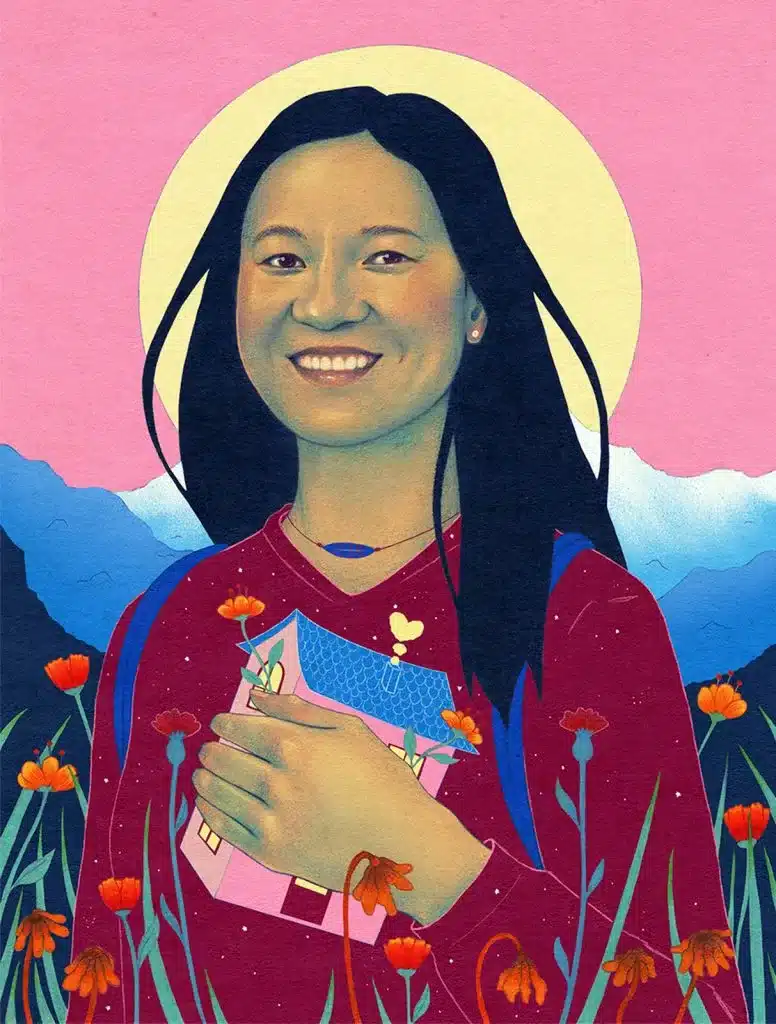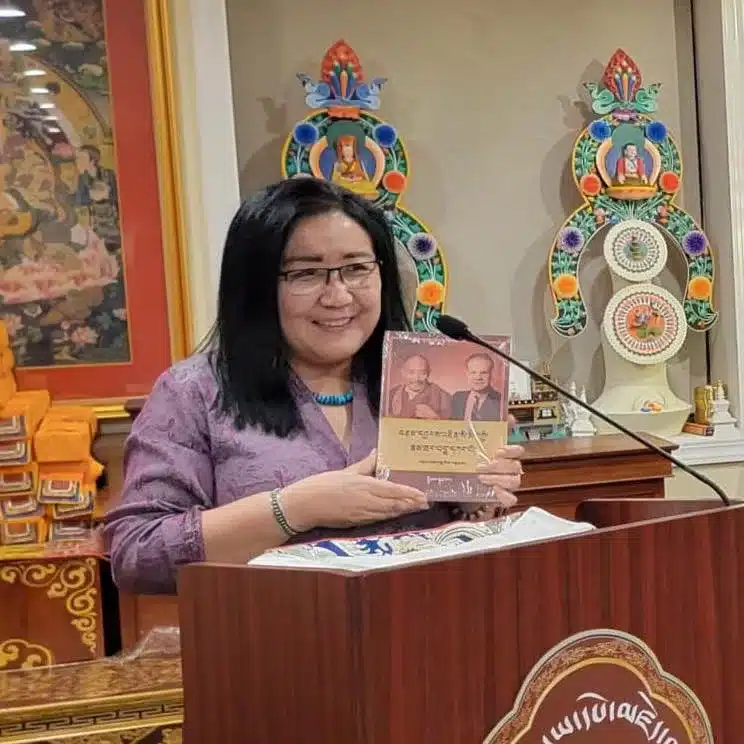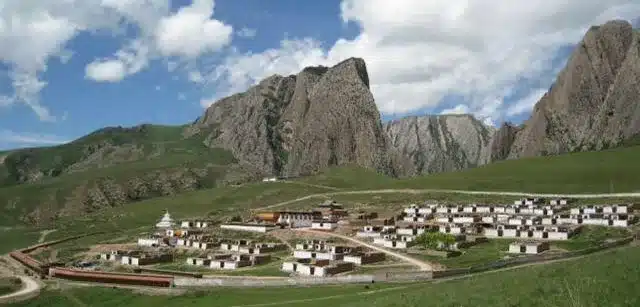
Portrait of Tibetan poet Tsering Wangmo Dhompa by Natalie Foss
Women's History Month is the perfect time to highlight BDRC's Database of Contemporary Tibetan Women, which has recently been significantly expanded and enhanced.
At BDRC we have always valued and sought out writings by Buddhist women, but women have been comparatively invisible throughout Tibetan history. Buddhist writings that women authors composed were not always preserved in pre-modern times, and as a result only about 3-4% of BDRC's person records of authors were women. This is a reflection of the patriarchal nature of human history in general, and Tibetan history in particular. Tibetan textual history has mostly been men writing texts about other men; where women are mentioned, it's often because of their relationships—because they are adjacent to an important man, as mother, daughter, wife, consort or student—and not because of their achievements.
In the contemporary period, however, due to expanded educational opportunities and concerted efforts by Tibetan women, there are hundreds of Tibetan women authors who are highly productive and influential. BDRC wanted to recognize and document their important writings by creating or enhancing person records for as many Tibetan women writers as we are aware of. A project funded by the US Agency for International Development has enabled us to double the number of contemporary women on the archive. Thanks to recent work by BDRC staff, the BUDA archive is now likely the most extensive database of modern Tibetan women available.
BDRC's extensive knowledge map of modern and contemporary Tibetan women authors and female figures (20th and 21st century Tibetan women) now contains a total of 376 records. They include enhanced BDRC Person metadata for 60% of all women authors and figures already existing in the database (194 Person Records), and 170 newly created person records for 165 new women authors and significant figures. This is an important addition to the public knowledge commons exemplified by the open-access BDRC archive.
All 376 records in this knowledge map include pertinent information and links to major writings, as well as biographical narratives. The narratives expand upon the details in the main part of the records with comments on an author's style, influence, and impact, or the historical significance of a particular public figure. For a representative example of the biographical narratives in this database of women we can quote from the record of BDRC's own Kelsang Lhamo. She is the longest serving employee at BDRC–hired by Gene Smith himself in 1999–and a well-regarded Tibetan author. The first paragraph of her narrative on BDRC reads,
"A prominent Tibetan writer known for her ornate poetry. She was born in Lhoka in 1973, although her birth year is sometimes listed erroneously as 1967. She studied with Sheldrak Khen Rinpoche and Dungkar Losang Trinlé. To pursue further studies, she went to India in 1989. She received novice vows from the 14th Dalai Lama and lived as a retreatant for a period of ten years. In 1999, she published Dreaming at the Sage's Abode, her first book of poetry, which was also the first book by a Tibetan woman writer in exile."

Kelsang Lhamo at the book launch of The White Lotus Biography of Jamyang Gene Smith at the Himalayan Library in New York City on March 11, 2023
Some other examples of enhanced Person Records:
Kunchok Tenpai Wangmo was a teacher and abbess from Rebkong in eastern Tibet. She was the Sixth Gungri Khandro, one of the few female reincarnate lines in Tibet. Her seat, Drakar monastery in Gengya, Rebkong, also called Sangngak Mingye Ling, was founded in 1644 and is affiliated with Labrang Monastery. In this record the primary title and primary name in English was added, her teacher was added, and a biographical note in Tibetan and English was added: གུང་རི་མཁའ་འགྲོ ༠༦་དཀོན་མཆོག་བསྟན་པའི་དབང་མོ། Gungri Khandro 1892-1936, P6538.

Sangngak Mingye Ling, a Geluk monastery in Sangchu County, Amdo, near Labrang Monastery, which is the seat of the Gungri Khandro incarnation.
Palmo is a writer, editor, professor and intellectual, who edited the first ever anthology of Tibetan women's poetry. Sholung: Collection of Contemporary Writing by Tibetan Women (བཞོ་ལུང་༏ དེང་རབས་བོད་ཀྱི་བུད་མེད་རྩོམ་པ་པོའི་སྙན་རྩོམ་གཅེས་བཏུས༏), was published by People's Printing Press in Beijing in 2004. In 2009 Palmo founded the "Demoness Welfare Association for Women", which carries out educational and cultural projects focused on women's literature and healthcare for rural women and nuns. Despite being one of the most important Tibetan woman writers and editors working today, Palmo barely has a digital footprint on the internet, and basically no English language presence at all. However, the record for Palmo on BDRC has now been enhanced with pen name, name in English, and a detailed brief biography including information on her background and her works. དཔལ་མོ། Palmo b. 1968, P6650.
Jamyang Kyi is known as a singer, song-writer, and a writer, and as a well-known public intellectual in Tibet, with many fans following both her music and her writing. She is one of the most visible Tibetan feminists, with many writings on Tibetan women's issues. Her book Neither Snow Nor Rain: The Life of Tibetan Women (ཟ་མ་མོའི་སྐྱིད་སྡུག་གངས་མ་ཆར༏), a collection of essays on Tibetan women's life and Tibetan women's literature, was published in 2008, and another collection of writing on women in Tibet, called Looking at Women's Issues (སྐྱེས་མའི་གནས་སྟངས་ཟུར་བལྟས་ལེབ་མཐོང་༏) was published in 2011, both by Kansu People's Printing Press (ཀན་སུའུ་མི་རིགས་དཔེ་སྐྲུན་ཁང་༏). འཇམ་དབྱངས་སྐྱིད། Jamyang Kyi, b. 1965, P1KG522.
Some examples of newly created Person Records:
Poet, writer and professor Tsering Wangmo Dhompa is probably the most successful and well known Tibetan woman writer outside the Tibetan sphere. She's known internationally, and has several books in English, but there is little written about her in Tibetan and so until recently there was no record of her on BUDA, the largest online library and database of Tibetan works in the world. A person record has now been created with biographical information in both Tibetan and English: ཚེ་རིང་དབང་མོ་དོམ་པ། Tsering Wangmo Dhompa b. 1969, P1TD119
Tsering Dolma created the largest network of mainstream Tibetan schools for Tibetan children in the 20th century. The archive now includes a newly created Person record for her, enhanced with dates, and family relationships, as well as a brief biography of her life: ཚེ་རིང་སྒྲོལ་མ༏ Tsering Dolma 1920-1964, P1TD116
These are women who deserve to be recorded in Tibetan history, and certainly in the largest Tibetan digital library and database. Doubling the number of contemporary women recorded in the archive is an important step towards equality and full representation of Tibetan women in the global knowledge commons. Intentionally highlighting women and their work in this way is key to preserving their history and their intellectual contributions, and a meaningful way to empower women in Tibetan society. It's also a step towards preserving and securing contemporary Tibetan history and culture while building gender equity and empowerment at the same time.
View works by women authors here in the BDRC archive.





Sorry, the comment form is closed at this time.